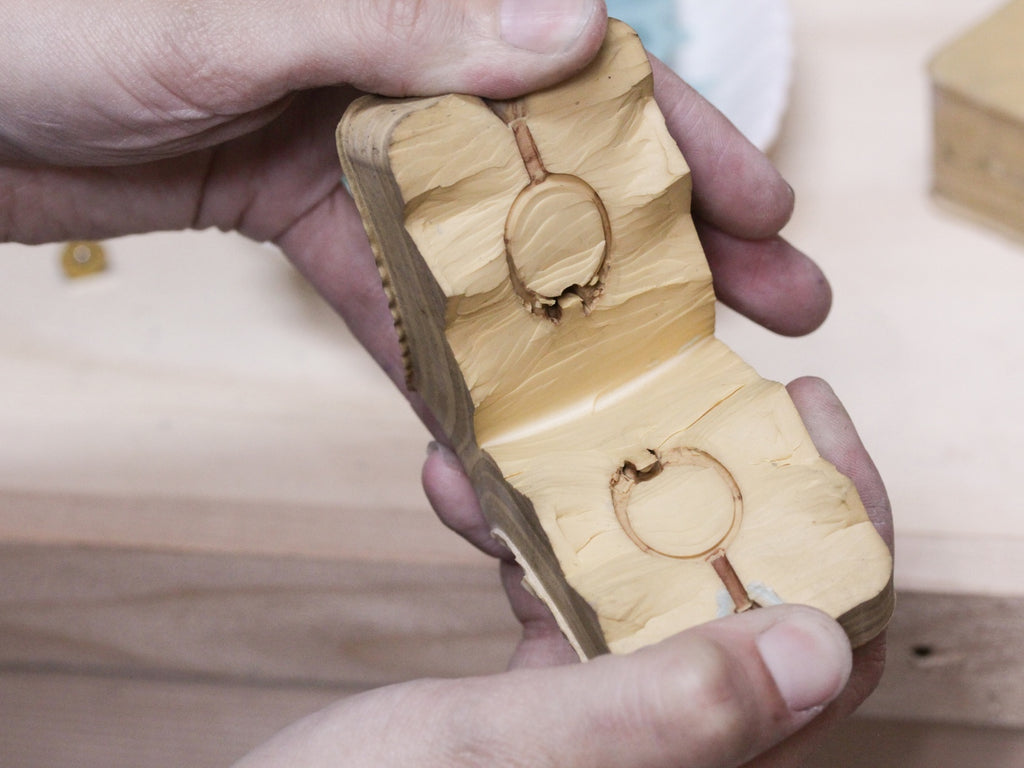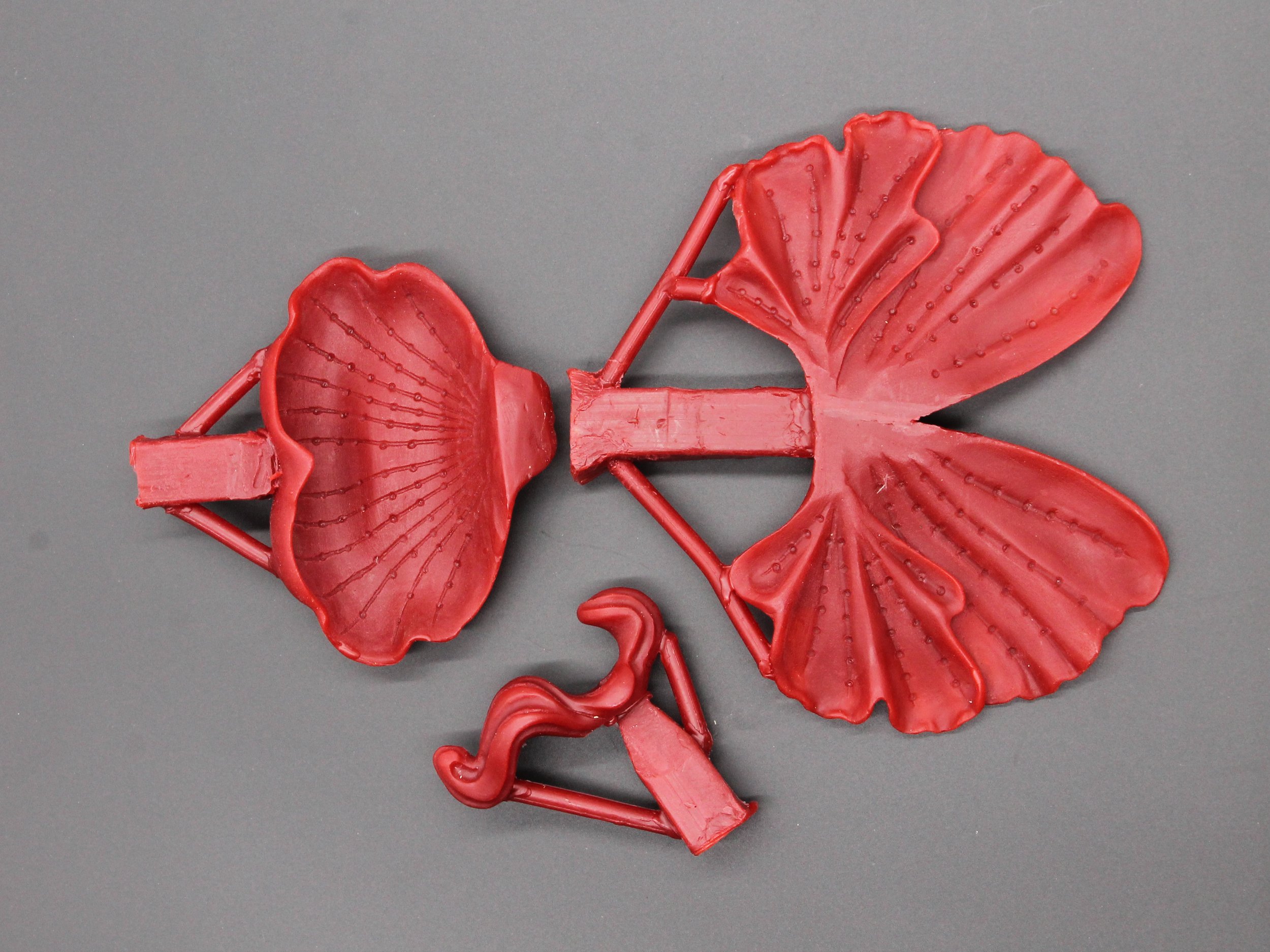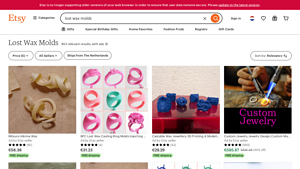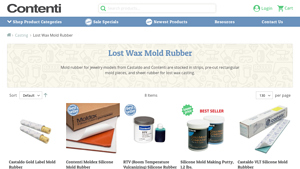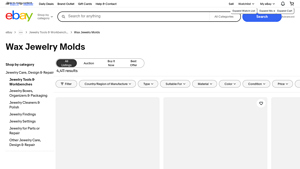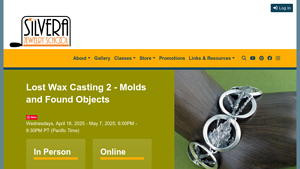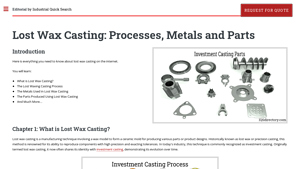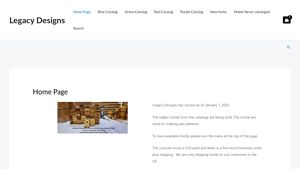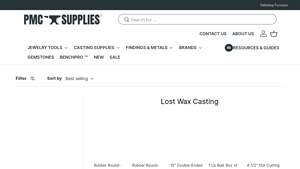Lost Wax Casting Molds Guide: Type, Cost, Top List…
Introduction: Navigating the Global Market for lost wax casting molds
In the dynamic realm of industrial manufacturing, sourcing lost wax casting molds poses a significant challenge for international B2B buyers. As businesses seek to produce intricate metal components with precision and efficiency, understanding the complexities of lost wax casting is crucial. This comprehensive guide delves into the various types of molds available, their diverse applications across industries, and essential supplier vetting strategies. Additionally, it provides insights into cost considerations and best practices for successful procurement, ensuring that buyers can navigate the market with confidence.
By addressing the unique needs of B2B buyers from Africa, South America, the Middle East, and Europe, including countries like Nigeria and Vietnam, this guide empowers decision-makers to make informed purchasing choices. The lost wax casting process is not only pivotal for jewelry and art but also for sectors like automotive and aerospace, where precision is paramount. With actionable insights and a thorough understanding of market dynamics, readers will be equipped to select the right molds and suppliers, ultimately enhancing their production capabilities and competitive edge. The following sections will provide an in-depth exploration of the lost wax casting landscape, ensuring that buyers are well-prepared to meet their business needs in an increasingly globalized market.
Understanding lost wax casting molds Types and Variations
| Type Name | Key Distinguishing Features | Primary B2B Applications | Brief Pros & Cons for Buyers |
|---|---|---|---|
| Traditional Wax Molds | Hand-carved wax patterns, suitable for detailed designs | Jewelry, art pieces, high-precision components | Pros: High detail, customizable; Cons: Labor-intensive, longer production time. |
| Silicone Rubber Molds | Flexible, reusable, and can capture fine details | Mass production of jewelry, prototypes | Pros: Quick turnaround, durable; Cons: Higher initial costs, may not capture all details as well as wax. |
| RTV Silicone Molds | Room temperature vulcanizing, ideal for intricate shapes | Industrial parts, prototypes, jewelry | Pros: Excellent detail reproduction, suitable for complex geometries; Cons: Limited lifespan, requires careful handling. |
| Castaldo Mold Rubber | Specialized rubber for jewelry, available in various grades | Jewelry industry, fine arts | Pros: Versatile, can create multiple copies; Cons: May require specific conditions for optimal results. |
| Investment Casting Molds | Uses a ceramic shell, ideal for high-volume production | Aerospace, automotive, medical devices | Pros: High strength, excellent surface finish; Cons: More complex setup, higher cost. |
What Are the Characteristics and Suitability of Traditional Wax Molds?
Traditional wax molds are crafted by hand-carving wax patterns, making them ideal for producing intricate designs with high precision. This method is particularly suitable for jewelry and art pieces where detail is paramount. B2B buyers should consider the labor-intensive nature of this process, which can lead to longer production times. However, the ability to customize designs extensively makes traditional wax molds a valuable option for businesses seeking unique, high-quality products.
How Do Silicone Rubber Molds Compare in the Market?
Silicone rubber molds are flexible and reusable, allowing for rapid production of items while capturing fine details. They are particularly advantageous in mass production scenarios, such as jewelry manufacturing and prototyping. B2B buyers should weigh the higher initial investment against the benefits of quick turnaround times and durability. While silicone molds may not capture every detail as finely as wax, they offer significant efficiencies for businesses focused on volume.
What Are the Benefits of RTV Silicone Molds for Complex Designs?
Room temperature vulcanizing (RTV) silicone molds are known for their ability to reproduce intricate shapes and fine details, making them suitable for industrial parts, prototypes, and jewelry. B2B buyers should note that while RTV molds excel in detail reproduction, they have a limited lifespan and require careful handling to avoid damage. This type of mold is ideal for companies that prioritize precision and complexity in their designs.
Why Choose Castaldo Mold Rubber for Jewelry Production?
Castaldo mold rubber is specifically designed for the jewelry industry, available in various grades to meet different production needs. Its versatility allows for the creation of multiple copies, making it a smart choice for businesses focusing on high-volume jewelry production. B2B buyers should consider that optimal results may require specific conditions, but the ability to replicate designs efficiently can significantly enhance productivity.
What Are the Key Features of Investment Casting Molds?
Investment casting molds utilize a ceramic shell, making them ideal for high-volume production across industries like aerospace, automotive, and medical devices. This method offers high strength and an excellent surface finish, appealing to B2B buyers seeking durable and precise components. However, the complexity of the setup and higher costs associated with investment casting should be carefully evaluated against the production needs and budget constraints of the business.
Key Industrial Applications of lost wax casting molds
| Industry/Sector | Specific Application of lost wax casting molds | Value/Benefit for the Business | Key Sourcing Considerations for this Application |
|---|---|---|---|
| Jewelry Manufacturing | Creation of intricate jewelry designs and custom pieces | High precision and detailed craftsmanship, allowing for unique offerings | Sourcing quality mold materials and experienced artisans for production |
| Aerospace | Production of complex components like turbine blades | Lightweight yet durable parts that enhance performance and efficiency | Need for certified materials that meet strict safety and regulatory standards |
| Automotive | Manufacturing of engine parts and custom components | Reduction in weight and improvement in fuel efficiency | Suppliers should provide consistent quality and rapid turnaround times |
| Medical Devices | Fabrication of surgical instruments and implants | High accuracy and biocompatibility for enhanced patient safety | Compliance with health regulations and the ability to produce sterile products |
| Art and Sculpting | Creation of unique art pieces and sculptures | Ability to replicate detailed designs and achieve artistic expression | Artisans must have experience in fine detail work and access to quality casting materials |
How is Lost Wax Casting Used in Jewelry Manufacturing?
In the jewelry sector, lost wax casting molds are essential for creating intricate designs and custom pieces. This method allows jewelers to reproduce detailed models with high precision, catering to consumer demand for unique and personalized items. Buyers in this sector should prioritize sourcing high-quality mold materials and experienced artisans to ensure the final products meet both aesthetic and durability standards. Additionally, understanding local market trends in regions like Africa and South America can help in tailoring designs that resonate with target audiences.
What Role Does Lost Wax Casting Play in Aerospace?
In aerospace, lost wax casting is utilized for producing complex components, such as turbine blades, where precision and lightweight materials are critical. The casting process enables manufacturers to create parts that enhance overall performance and fuel efficiency. For international buyers, particularly from the Middle East and Europe, it is vital to source certified materials that comply with stringent safety and regulatory standards, ensuring reliability in high-stakes applications.
How is Lost Wax Casting Applied in Automotive Manufacturing?
The automotive industry employs lost wax casting to manufacture various engine parts and custom components. This technique allows for weight reduction, which is crucial for improving fuel efficiency and overall vehicle performance. Automotive buyers need to seek suppliers that can consistently deliver high-quality castings with rapid turnaround times to meet production schedules and market demands, especially in fast-growing markets in Africa and South America.
In What Ways is Lost Wax Casting Used in Medical Devices?
Lost wax casting is significant in the medical field for fabricating surgical instruments and implants. The precision of this method ensures that products are not only accurate but also biocompatible, enhancing patient safety. Buyers in this sector must ensure that their suppliers comply with health regulations and possess the capability to produce sterile products, which is particularly important for international markets where standards may vary.
How is Lost Wax Casting Beneficial for Art and Sculpting?
Artists and sculptors leverage lost wax casting to create unique art pieces that require a high level of detail and craftsmanship. This method allows for the replication of intricate designs, facilitating artistic expression. For artists sourcing materials, it is crucial to work with suppliers who have experience in fine detail work and can provide quality casting materials, ensuring that their artistic vision is realized effectively.
3 Common User Pain Points for ‘lost wax casting molds’ & Their Solutions
Scenario 1: High Failure Rates in Casting Quality
The Problem: Many B2B buyers, particularly those in the jewelry and metalworking sectors, encounter significant challenges with the quality of their castings. This often manifests as defects such as porosity, incomplete fills, or surface imperfections. These issues not only waste valuable materials and time but also lead to dissatisfied customers and financial losses. Buyers may struggle with understanding the root causes of these failures, which can stem from improper mold preparation, inadequate spruing, or even the choice of materials.
The Solution: To mitigate casting quality issues, buyers should prioritize thorough training for their team on the lost wax casting process. This includes investing in workshops or courses that cover essential techniques such as mold preparation, wax carving, and spruing. Additionally, sourcing high-quality materials, such as premium silicone mold rubbers and investment materials, is crucial. Buyers should evaluate suppliers based on product specifications and user reviews. Furthermore, implementing a rigorous quality control process during the casting phase—such as monitoring temperatures and ensuring proper investment mixing—can significantly enhance casting outcomes. Utilizing technologies like 3D modeling can also assist in optimizing designs before mold creation, reducing the likelihood of defects.
Scenario 2: Difficulty in Sourcing High-Quality Molds
The Problem: B2B buyers often face challenges in sourcing high-quality lost wax casting molds that meet their specific production needs. In regions such as Africa and South America, the availability of reliable suppliers can be limited, leading to inconsistent quality and performance of molds. Buyers may find it difficult to distinguish between various mold materials, such as RTV silicone or polyurethane, which can affect the longevity and fidelity of the molds.
The Solution: Buyers should conduct thorough market research to identify reputable suppliers with a proven track record in lost wax casting molds. This includes seeking recommendations from industry peers and utilizing online platforms that specialize in metalworking supplies. When evaluating suppliers, it is crucial to request samples or small batches to assess the quality before committing to larger orders. Additionally, investing in custom molds that are tailored to specific designs can enhance production efficiency. Collaborating with manufacturers to develop molds that utilize advanced materials can also improve mold durability and casting accuracy. Buyers should establish strong communication with suppliers to ensure they are informed about the latest advancements in mold technology.
Scenario 3: Inefficient Production Processes
The Problem: Many companies experience inefficiencies in their production processes due to outdated techniques or inadequate tooling. This can lead to longer lead times, increased labor costs, and an inability to scale operations effectively. B2B buyers may feel pressure to deliver high-quality products quickly, but without efficient processes, they may struggle to meet customer demands.
The Solution: To enhance production efficiency, buyers should evaluate their existing workflows and identify bottlenecks. Implementing modern lost wax casting techniques, such as vacuum casting or pressure casting, can significantly improve turnaround times and product quality. Additionally, investing in automation tools and equipment can streamline processes, from wax injection to mold filling. Buyers should also consider utilizing software solutions for managing production schedules and inventory, which can help optimize resource allocation. Regular training sessions for staff on best practices in lost wax casting will ensure that all team members are equipped with the latest techniques, leading to a more efficient and productive operation. By continuously assessing and adapting their processes, companies can position themselves to meet market demands effectively.
Strategic Material Selection Guide for lost wax casting molds
What Are the Key Materials for Lost Wax Casting Molds?
When selecting materials for lost wax casting molds, it is essential to consider the unique properties and performance characteristics of each option. Here, we analyze four common materials used in the industry: silicone rubber, metal, plaster, and investment ceramics. Each material presents distinct advantages and limitations that can significantly impact the casting process and final product quality.
How Does Silicone Rubber Perform in Lost Wax Casting?
Silicone rubber is widely used for creating molds due to its flexibility and ease of use. It can withstand temperatures up to 200°C (392°F) without degrading, making it suitable for casting metals like silver and gold. Silicone rubber molds are known for their excellent detail reproduction and can be used for multiple castings without significant wear.
Pros: The main advantages include high detail fidelity, ease of demolding, and resistance to many chemicals. Silicone molds can also be produced quickly, which is beneficial for high-volume production.
Cons: However, silicone rubber can be relatively expensive compared to other materials and may not withstand extreme temperatures beyond its rating. Additionally, it may not be suitable for all metal types, particularly those with higher melting points.
What Role Does Metal Play in Lost Wax Casting Molds?
Metal molds, typically made from aluminum or steel, are durable and can withstand high temperatures, making them ideal for casting processes involving metals with high melting points. They provide excellent thermal conductivity, ensuring even heating and cooling during the casting process.
Pros: The key advantage of metal molds is their longevity and ability to produce high-quality castings consistently. They are also reusable, making them cost-effective over time for large production runs.
Cons: The primary drawback is the initial cost and complexity of manufacturing metal molds, which can require specialized equipment and processes. Additionally, they may not capture intricate details as effectively as silicone molds.
How Effective Are Plaster Molds for Lost Wax Casting?
Plaster molds are often used for smaller-scale or one-off castings. They are made from a mixture of plaster and water, which hardens to form a rigid mold. Plaster can withstand temperatures up to approximately 600°C (1112°F), making it suitable for a variety of metals.
Pros: The advantages of plaster molds include low cost and ease of preparation. They can capture fine details well and are readily available in many regions.
Cons: However, plaster molds can be fragile and may not be suitable for high-volume production. They also require time to set and cure, which can slow down the overall casting process.
What Are the Benefits of Investment Ceramics in Lost Wax Casting?
Investment ceramics, often referred to as investment casting, utilize a ceramic shell to create molds. This method allows for high precision and is particularly effective for complex shapes and fine details.
Pros: Investment ceramics can withstand very high temperatures, making them suitable for casting a wide range of metals. They provide excellent surface finish and dimensional accuracy.
Cons: The main limitations include higher costs and the complexity of the investment process, which can require specialized knowledge and equipment. The production time can also be longer compared to other materials.
Summary Table of Material Selection for Lost Wax Casting Molds
| Material | Typical Use Case for lost wax casting molds | Key Advantage | Key Disadvantage/Limitation | Relative Cost (Low/Med/High) |
|---|---|---|---|---|
| Silicone Rubber | Jewelry and small-scale metal objects | High detail fidelity and flexibility | Higher cost and limited temperature range | Medium |
| Metal | High-volume production for durable items | Long-lasting and reusable | High initial cost and manufacturing complexity | High |
| Plaster | One-off castings and small-scale production | Low cost and easy to prepare | Fragile and slower setting time | Low |
| Investment Ceramics | Complex shapes and fine details | High precision and temperature resistance | Higher costs and complex process | High |
This strategic guide provides B2B buyers with actionable insights into material selection for lost wax casting molds, ensuring they can make informed decisions that align with their production needs and market standards.
In-depth Look: Manufacturing Processes and Quality Assurance for lost wax casting molds
What Are the Key Stages in the Manufacturing Process of Lost Wax Casting Molds?
The manufacturing process for lost wax casting molds involves several critical stages: material preparation, forming, assembly, and finishing. Each stage is integral to ensuring that the final product meets the required specifications for quality and precision.
Material Preparation: How Is the Right Material Chosen?
The first step in the lost wax casting process is selecting the appropriate materials. Common materials include wax for the original model, silicone or rubber for the mold, and investment materials such as plaster or ceramic for the outer shell. The choice of materials can significantly affect the quality and accuracy of the final cast. For instance, using high-quality silicone mold rubber can enhance the detail captured in the mold, which is crucial for intricate designs.
Forming: What Techniques Are Used to Create Molds?
Once materials are prepared, the forming process begins. This typically involves several techniques:
-
Wax Model Creation: The initial model is crafted from wax, which can be shaped and carved to achieve the desired design. This step is often done manually, allowing for intricate detailing.
-
Mold Making: The wax model is then encased in a silicone or rubber material to create the mold. This involves pouring the silicone over the wax model, ensuring all details are captured.
-
Investment Casting: After the mold is set, it is filled with an investment material. This investment hardens around the mold, creating a shell that can withstand the high temperatures of molten metal.
Assembly: How Are Molds Prepared for Casting?
Assembly involves integrating multiple wax patterns into a single tree-like structure known as a sprue system. This system allows molten metal to flow into all parts of the mold simultaneously. The placement and design of the sprue are crucial; improper spruing can lead to incomplete casts or defects.
The assembly phase also includes attaching the sprue to the investment flask, which is essential for the next step—pouring the metal.
Finishing: What Steps Ensure Quality in the Final Product?
After the metal has cooled and solidified, the investment material is removed, revealing the cast object. The finishing process involves several steps:
- Cleaning: Removal of any residual investment material, often through sandblasting or ultrasonic cleaning.
- Polishing: Enhancing the surface finish of the cast item to meet aesthetic or functional requirements.
- Inspection: The final product is inspected for defects, dimensional accuracy, and surface quality.
What Quality Assurance Measures Are Essential for Lost Wax Casting?
Quality assurance (QA) in lost wax casting is crucial to ensure that products meet international standards and customer expectations. Various international standards, such as ISO 9001, guide the implementation of effective QA processes.
Which International Standards Should B2B Buyers Be Aware Of?
B2B buyers should familiarize themselves with several international and industry-specific standards:
- ISO 9001: This standard outlines the requirements for a quality management system and is crucial for ensuring consistent quality in manufacturing processes.
- CE Marking: In Europe, products must comply with health, safety, and environmental protection standards to carry the CE mark.
- API Standards: For industries like oil and gas, adherence to American Petroleum Institute standards is often required.
What Are the Key Quality Control Checkpoints?
Quality control (QC) involves systematic monitoring of various stages in the manufacturing process. Key checkpoints include:
-
Incoming Quality Control (IQC): This involves inspecting raw materials and components before production begins. Ensuring the quality of materials is vital for achieving the desired product quality.
-
In-Process Quality Control (IPQC): Monitoring the production process itself to identify and rectify issues in real-time. This includes regular checks during mold making and casting.
-
Final Quality Control (FQC): Conducting a thorough inspection of the final product before shipment. This includes dimensional checks, surface finish assessments, and functional testing where applicable.
How Can B2B Buyers Verify Supplier Quality Control Practices?
For B2B buyers, verifying a supplier’s QC practices is essential to ensure that they receive high-quality products. Here are several strategies to consider:
-
Supplier Audits: Conducting regular audits of suppliers’ facilities can provide insights into their manufacturing and quality assurance processes. This helps verify compliance with international standards.
-
Requesting Quality Reports: Suppliers should provide documentation of their QC processes, including results from IQC, IPQC, and FQC. These reports can offer transparency regarding the quality of materials and finished products.
-
Third-Party Inspections: Engaging third-party inspection services can provide an unbiased evaluation of the supplier’s processes and products. This is particularly useful for international buyers who may not have the ability to conduct onsite inspections.
What QC Considerations Are Unique for International B2B Buyers?
International B2B buyers, particularly from regions like Africa, South America, the Middle East, and Europe, face unique challenges in quality assurance. Understanding the nuances of QC requirements in different markets is essential for smooth transactions.
-
Regulatory Compliance: Different regions may have varying regulations regarding materials and production processes. Buyers should ensure that their suppliers are compliant with local laws and international standards.
-
Cultural Considerations: Different countries may have varying expectations regarding quality and service. Establishing clear communication channels and understanding cultural differences can help in managing expectations and ensuring satisfaction.
-
Logistical Challenges: International shipping can introduce additional risks to product quality. Ensuring that suppliers have robust packaging and handling procedures can mitigate these risks.
In conclusion, understanding the manufacturing processes and quality assurance measures for lost wax casting molds is crucial for B2B buyers. By focusing on material selection, manufacturing techniques, and rigorous quality control, buyers can ensure they are sourcing high-quality products that meet their specific needs.
Practical Sourcing Guide: A Step-by-Step Checklist for ‘lost wax casting molds’
This practical sourcing guide is designed to assist B2B buyers in effectively procuring lost wax casting molds. Whether you’re a manufacturer, jeweler, or artisan, following this checklist will ensure that you select the right molds for your specific needs, enhancing your production efficiency and product quality.
Step 1: Define Your Technical Specifications
Before initiating the procurement process, clearly outline your technical requirements. This includes dimensions, material types (e.g., silicone, rubber), and the complexity of the designs you intend to cast. Having precise specifications helps streamline communications with suppliers and ensures that the molds produced meet your production needs.
- Considerations: Identify the types of metals you will be casting and ensure the molds can withstand the necessary temperatures and pressures.
Step 2: Conduct Market Research for Suppliers
Research potential suppliers in the lost wax casting mold market. Look for companies with a solid reputation and proven experience in the industry. Utilize platforms like trade shows, online directories, and industry forums to gather information on various suppliers.
- Tips: Focus on suppliers that cater to your geographic region, particularly those familiar with local market demands and regulations.
Step 3: Evaluate Supplier Certifications and Quality Assurance
Ensure that the suppliers you are considering have relevant certifications, such as ISO 9001, which indicates adherence to quality management standards. This step is crucial as it reflects the supplier’s commitment to producing high-quality molds.
- Key Actions: Request copies of certifications and ask about their quality control processes. Inquire about any testing procedures for the molds.
Step 4: Request Samples for Testing
Before making a bulk purchase, always request samples of the molds. Testing samples allows you to assess the quality, durability, and suitability of the molds for your specific applications.
- What to Look For: Evaluate the samples for dimensional accuracy, surface finish, and overall craftsmanship. Consider performing a test casting to gauge how well the mold performs under actual production conditions.
Step 5: Negotiate Pricing and Payment Terms
Once you have identified suitable suppliers, initiate negotiations on pricing and payment terms. Understanding the cost structure is essential for budgeting and financial planning.
- Strategies: Discuss bulk discounts and inquire about any hidden costs such as shipping or customs fees. Establish clear payment terms to avoid disputes later in the process.
Step 6: Establish Communication Protocols
Effective communication with your chosen supplier is vital for a successful partnership. Establish protocols for regular updates and feedback throughout the procurement process.
- Best Practices: Use tools like project management software or shared documents to keep track of timelines, changes, and approvals. Ensure that both parties understand the expectations and deliverables.
Step 7: Review and Finalize Contracts
Before finalizing your order, carefully review the contract terms. Ensure that all aspects of the agreement, including delivery timelines, warranty conditions, and return policies, are clearly outlined.
- Important Notes: Pay attention to clauses that may affect your rights in case of defective products or delays. Having a well-defined contract protects your investment and fosters a professional relationship.
By following this checklist, B2B buyers can make informed decisions when sourcing lost wax casting molds, ultimately leading to improved production outcomes and business success.
Comprehensive Cost and Pricing Analysis for lost wax casting molds Sourcing
What Are the Key Cost Components in Lost Wax Casting Molds?
When sourcing lost wax casting molds, understanding the cost structure is essential for making informed purchasing decisions. The primary cost components include materials, labor, manufacturing overhead, tooling, quality control (QC), logistics, and profit margins.
-
Materials: The choice of rubber or silicone for mold making significantly affects costs. For instance, Castaldo Gold Label Mold Rubber can range from $62.60 to over $500 for rolls, depending on the thickness and type. High-quality materials often yield better durability and precision in casting, thus impacting the overall cost.
-
Labor: Skilled labor is crucial in the mold-making process. The complexity of the mold design, the intricacy of the patterns, and the skill level of the artisans involved can lead to variations in labor costs. Additionally, specialized training in lost wax casting techniques can further influence pricing.
-
Manufacturing Overhead: This includes costs related to utilities, maintenance of machinery, and facility expenses. Efficient production processes can lower overhead costs, making it a critical area for suppliers to manage.
-
Tooling: Tooling costs encompass the equipment and machinery required to create molds. These costs are often amortized over the production run, meaning larger orders can lead to lower per-unit tooling costs.
-
Quality Control (QC): Ensuring molds meet specific quality standards can add to costs. Implementing robust QC measures helps minimize defects and ensures product reliability, which is especially important in sectors like jewelry or aerospace.
-
Logistics: Shipping and handling costs can vary based on the destination, weight, and dimensions of the molds. International buyers should consider these costs as they can significantly impact the total expenditure.
-
Margin: Suppliers typically add a profit margin on top of their costs. This margin can vary based on market competition and perceived value of the molds offered.
How Do Price Influencers Impact Sourcing of Lost Wax Casting Molds?
Several factors influence pricing for lost wax casting molds, making it essential for buyers to understand these dynamics.
-
Volume/MOQ: Suppliers often offer better pricing for larger orders. Minimum order quantities (MOQs) can lead to economies of scale, reducing per-unit costs.
-
Specifications and Customization: Custom molds tailored to specific designs or requirements typically come at a premium. Standard molds may be more cost-effective for bulk purchases.
-
Materials Used: The type of material selected for mold making directly affects the cost. Higher-quality materials may have upfront costs but can lead to better casting results and longer mold life.
-
Quality and Certifications: Molds that come with certifications for quality assurance may carry higher price tags but can be worth the investment for industries requiring strict compliance with standards.
-
Supplier Factors: The reputation and reliability of the supplier can impact pricing. Established suppliers may charge more due to their experience and track record, while newer suppliers may offer competitive rates to gain market entry.
-
Incoterms: The choice of Incoterms can influence logistics costs and responsibilities. Understanding terms like FOB (Free on Board) or CIF (Cost, Insurance, and Freight) is crucial for managing total costs effectively.
What Buyer Tips Can Enhance Cost-Efficiency in Sourcing?
To maximize cost-efficiency when sourcing lost wax casting molds, consider the following strategies:
-
Negotiation: Engage in price negotiations with suppliers, especially for larger orders. Building long-term relationships can also lead to better terms and discounts.
-
Total Cost of Ownership (TCO): Evaluate the total cost of ownership, including initial purchase price, maintenance, and potential replacement costs. A lower upfront cost may not always lead to the best long-term value.
-
Pricing Nuances for International Buyers: Be aware of currency fluctuations, import duties, and taxes that can affect the final cost. Collaborating with suppliers who understand the local market can help mitigate these risks.
-
Research and Comparison: Conduct thorough market research to compare prices and quality among different suppliers. Utilize online platforms to gather quotes and assess supplier capabilities.
-
Plan for Future Needs: Consider potential future requirements when placing orders. Forecasting demand can help in negotiating better deals and ensuring timely supply.
By understanding these cost components, pricing influencers, and strategic tips, international B2B buyers can make informed decisions that enhance their sourcing efficiency for lost wax casting molds. Keep in mind that prices fluctuate based on market conditions, so it is advisable to seek updated quotes and consult with multiple suppliers before finalizing any agreements.
Alternatives Analysis: Comparing lost wax casting molds With Other Solutions
Exploring Alternative Solutions to Lost Wax Casting Molds
In the realm of metalworking and jewelry manufacturing, lost wax casting molds have long been a favored method for creating intricate designs. However, there are alternative solutions that can offer different advantages depending on the specific needs of businesses. Understanding these alternatives can help B2B buyers make informed decisions tailored to their production requirements.
Comparison Table of Lost Wax Casting Molds and Alternatives
| Comparison Aspect | Lost Wax Casting Molds | 3D Printing (Additive Manufacturing) | Sand Casting |
|---|---|---|---|
| Performance | High precision and detail | Excellent for complex geometries | Moderate precision, less detail |
| Cost | Medium to high | Varies widely; can be high for advanced printers | Low to medium, depending on materials |
| Ease of Implementation | Requires skilled artisans | Requires design software and printer setup | Relatively simple; requires molds |
| Maintenance | Moderate (mold wear) | Low (printer upkeep) | Moderate (mold wear and repair) |
| Best Use Case | Jewelry, intricate designs | Prototyping, complex parts | Large, simple parts or prototypes |
In-Depth Analysis of Alternatives
3D Printing (Additive Manufacturing)
3D printing has emerged as a revolutionary technology in manufacturing, offering the capability to produce complex designs that would be challenging with traditional methods. The primary advantage of 3D printing is its flexibility; designs can be easily modified in software before printing. Additionally, it allows for rapid prototyping, which can significantly speed up the design process. However, the initial investment in high-quality printers and materials can be substantial, and the resulting products may sometimes lack the same level of surface finish and durability as those produced via lost wax casting.
Sand Casting
Sand casting is one of the oldest metal casting methods and is widely used for creating large parts. It involves creating a mold from sand and then pouring molten metal into it. One of the key benefits of sand casting is its low cost, particularly for large-scale production. It is ideal for simpler designs and larger components, making it suitable for automotive and industrial applications. However, sand casting does not achieve the fine detail and precision of lost wax casting, which may limit its use in high-end jewelry or intricate components. Maintenance of sand molds can also be a concern, as they wear down over time and may require frequent replacement.
Conclusion: Making the Right Choice for Your Business Needs
When selecting between lost wax casting molds and alternative solutions, businesses should carefully assess their specific requirements. Factors such as the level of detail needed, production volume, and budget constraints play a crucial role in determining the best approach. For intricate designs and high-quality jewelry, lost wax casting remains a superior choice. In contrast, if rapid prototyping or cost-effectiveness for larger parts is a priority, 3D printing or sand casting may provide the necessary advantages. By evaluating these factors, B2B buyers can align their production methods with their strategic goals, ensuring optimal results for their projects.
Essential Technical Properties and Trade Terminology for lost wax casting molds
What are the Key Technical Properties of Lost Wax Casting Molds?
Lost wax casting molds are critical components in the production of metal parts and jewelry. Understanding their technical specifications can guide B2B buyers in selecting the right molds for their applications. Here are some essential properties:
-
Material Grade
The material grade of the mold is crucial as it determines the mold’s durability and suitability for various metals. Common materials include silicone rubber and RTV (Room Temperature Vulcanizing) silicone, each with different thermal properties. Selecting the appropriate grade ensures that the mold can withstand the high temperatures of molten metal without degrading, which is vital for consistent quality in casting. -
Dimensional Tolerance
Dimensional tolerance refers to the allowable variation in the mold dimensions. It is essential for achieving precise castings that meet specific design requirements. High tolerance levels (e.g., ±0.01 mm) are critical in industries like aerospace and medical devices, where precision is paramount. Understanding tolerance requirements helps buyers ensure that the final products fit correctly and function as intended. -
Heat Resistance
The ability of a mold to withstand high temperatures is a key property. Molds must endure the heat generated by molten metal without warping or breaking down. Molds with higher heat resistance (typically rated at over 200°C) are preferable for casting metals like bronze and silver, ensuring the integrity of the mold and the quality of the cast product. -
Reusability
The number of times a mold can be reused before it degrades is an important consideration for cost-effectiveness. Molds designed for multiple uses can significantly lower production costs, especially for high-volume manufacturing. Buyers should assess the expected lifespan of the mold based on the intended production scale to optimize their investment. -
Surface Finish
The surface finish of the mold affects the final product’s texture and appearance. Molds with smoother finishes reduce the need for post-casting processing, such as polishing. This property is particularly important in jewelry and decorative items, where aesthetic qualities are critical. -
Flexibility
Flexibility in mold design allows for easier removal of the cast item without damaging it. This is particularly relevant for intricate designs or undercuts. Molds that offer a good balance between rigidity and flexibility can enhance production efficiency and reduce waste.
What are the Common Trade Terms in Lost Wax Casting?
Familiarity with industry terminology is essential for effective communication and negotiation in B2B transactions. Here are some common terms:
-
OEM (Original Equipment Manufacturer)
OEM refers to companies that produce parts or equipment that may be marketed by another manufacturer. In the context of lost wax casting, an OEM might provide specialized molds or components that meet specific customer requirements. -
MOQ (Minimum Order Quantity)
MOQ is the smallest amount of product a supplier is willing to sell. Understanding MOQs is essential for buyers to assess their purchasing options and manage inventory costs effectively. -
RFQ (Request for Quotation)
An RFQ is a document sent to suppliers requesting a quote for specific products or services. It typically outlines product specifications, quantities, and delivery requirements. Sending an RFQ helps buyers compare prices and terms from multiple suppliers. -
Incoterms (International Commercial Terms)
Incoterms are a set of predefined international rules that clarify the responsibilities of buyers and sellers in shipping goods. They specify who pays for shipping, insurance, and tariffs, which can significantly impact the overall cost of procurement. -
Lead Time
Lead time refers to the duration it takes from placing an order to receiving the goods. It is crucial for planning and inventory management. Buyers should always inquire about lead times to ensure they can meet their production schedules. -
Casting Yield
Casting yield is the ratio of the final product weight to the weight of the raw material used in casting. Higher yields indicate more efficient use of materials, which is vital for cost management in large-scale production.
By understanding these technical properties and trade terms, B2B buyers can make more informed decisions when sourcing lost wax casting molds, ultimately enhancing their production processes and product quality.
Navigating Market Dynamics and Sourcing Trends in the lost wax casting molds Sector
What Are the Current Market Dynamics and Key Trends in the Lost Wax Casting Molds Sector?
The lost wax casting molds sector is experiencing significant transformation driven by globalization, technological advancements, and evolving consumer preferences. One of the primary global drivers is the demand for customization in various industries, including jewelry, automotive, and aerospace. As international B2B buyers seek unique and bespoke products, the lost wax casting method’s ability to create intricate designs becomes increasingly valuable. Emerging technologies, such as 3D printing and digital modeling, are also reshaping the sourcing landscape. They enable faster prototyping and reduce lead times, which is crucial for businesses looking to remain competitive.
Furthermore, the rise of e-commerce platforms has made it easier for B2B buyers from regions like Africa, South America, and the Middle East to access suppliers globally. This shift is facilitating direct sourcing and reducing dependency on local intermediaries. Buyers are increasingly prioritizing suppliers that offer comprehensive services, including design assistance, rapid prototyping, and after-sales support. The market is also witnessing a trend towards integrating smart technologies, such as IoT, for monitoring production processes, enhancing quality control, and improving supply chain efficiencies.
How Are Sustainability and Ethical Sourcing Impacting the Lost Wax Casting Molds Sector?
Sustainability and ethical sourcing have become essential considerations for B2B buyers in the lost wax casting molds sector. The environmental impact of traditional casting processes, which often involve significant energy consumption and waste generation, is prompting businesses to seek greener alternatives. Suppliers are increasingly adopting eco-friendly materials and processes, such as using recycled metals and water-based investment materials, to minimize their carbon footprint.
Ethical supply chains are gaining prominence as buyers demand transparency regarding sourcing practices. This includes verifying that raw materials are sourced responsibly and that production methods adhere to labor standards. Certifications such as ISO 14001 for environmental management and Fair Trade for ethical sourcing are becoming benchmarks for assessing suppliers. Buyers who prioritize suppliers with these certifications not only enhance their brand image but also align with consumer expectations for sustainability.
Moreover, the shift towards sustainable practices is influencing innovation in the sector. Companies are investing in research and development to create new materials that are both environmentally friendly and high-performing, further driving the industry towards a more sustainable future.
How Has the Lost Wax Casting Process Evolved Over Time?
The lost wax casting process has a rich history that dates back thousands of years, originally used by ancient civilizations for crafting jewelry and artistic objects. The technique involves creating a model in wax, encasing it in a mold, and then melting away the wax to leave a cavity for molten metal. This method allows for the production of complex shapes and fine details that are challenging to achieve with other casting techniques.
Over the years, advancements in materials and technology have significantly enhanced the lost wax casting process. The introduction of silicone molds and modern investment materials has improved the accuracy and efficiency of casting. Additionally, the integration of computer-aided design (CAD) and 3D printing technologies has revolutionized how molds are created, enabling faster prototyping and greater customization.
Today, lost wax casting is not only a traditional artisan craft but also a highly technical manufacturing process. This evolution reflects the growing demand for precision and quality in various industries, making lost wax casting molds an essential component for international B2B buyers looking to meet modern market needs.
Frequently Asked Questions (FAQs) for B2B Buyers of lost wax casting molds
-
How do I choose the right lost wax casting mold supplier?
When selecting a supplier for lost wax casting molds, prioritize companies with a proven track record in the industry and positive client testimonials. Evaluate their manufacturing capabilities, including technology and materials used, to ensure they meet your specific requirements. Additionally, request samples to assess the quality of their molds. It’s crucial to confirm that the supplier complies with international quality standards and regulations, especially if you’re sourcing from regions like Africa or South America, where standards may vary. -
What are the typical minimum order quantities (MOQs) for lost wax casting molds?
Minimum order quantities can vary significantly among suppliers, often depending on the complexity of the molds and the materials used. Generally, MOQs may range from 50 to several hundred units. When negotiating, consider your production needs and discuss potential flexibility with the supplier. Some manufacturers might offer lower MOQs for first-time orders or for custom designs, which can be beneficial for small businesses or startups. -
What customization options are available for lost wax casting molds?
Most suppliers offer customization options to meet specific design and production needs. This can include adjustments in mold size, shape, and material type. When discussing customization, be clear about your requirements and any specific industry standards you must adhere to. Requesting a prototype or sample before full production can help ensure that the final product aligns with your expectations. -
What payment terms should I expect when sourcing lost wax casting molds internationally?
Payment terms can vary widely based on the supplier’s policies and the nature of your order. Common arrangements include upfront payments, partial payments, or payment upon delivery. International transactions may also involve letters of credit or escrow services for added security. Always negotiate terms that protect your interests, especially when dealing with new suppliers, and ensure clarity on currency conversion rates and fees. -
How can I ensure quality assurance for lost wax casting molds?
To ensure quality assurance, establish clear specifications and standards before placing an order. Request documentation of quality control processes from your supplier, including certifications and inspection reports. Conduct on-site visits if possible, or arrange for third-party inspections to verify compliance with your standards. Regular communication during the production process can also help address any issues proactively. -
What logistics considerations should I keep in mind for international shipping of lost wax casting molds?
When planning logistics for shipping lost wax casting molds internationally, consider factors such as shipping methods, lead times, and customs regulations. Choose a reliable freight forwarder experienced in handling industrial shipments. Ensure that all required documentation, including commercial invoices and packing lists, is prepared to avoid customs delays. Additionally, factor in potential tariffs and taxes that may affect your overall costs. -
What materials are commonly used for lost wax casting molds?
Lost wax casting molds are typically made from a variety of materials, including silicone rubber, RTV (Room Temperature Vulcanizing) silicone, and metal. The choice of material depends on the specific casting application and the type of metal being used. Silicone molds are favored for their flexibility and detail reproduction, while metal molds are used for high-volume production due to their durability. Discuss material options with your supplier to determine the best fit for your project. -
How do I handle defects or issues with lost wax casting molds post-delivery?
In the event of defects or issues with your molds, promptly communicate with your supplier to address the concerns. Document the problems with photographs and detailed descriptions to facilitate discussions. Many reputable suppliers will have return or replacement policies in place. Ensure that your purchase agreement includes terms for handling defects to protect your business interests and facilitate a smooth resolution process.
Important Disclaimer & Terms of Use
⚠️ Important Disclaimer
The information provided in this guide, including content regarding manufacturers, technical specifications, and market analysis, is for informational and educational purposes only. It does not constitute professional procurement advice, financial advice, or legal advice.
While we have made every effort to ensure the accuracy and timeliness of the information, we are not responsible for any errors, omissions, or outdated information. Market conditions, company details, and technical standards are subject to change.
B2B buyers must conduct their own independent and thorough due diligence before making any purchasing decisions. This includes contacting suppliers directly, verifying certifications, requesting samples, and seeking professional consultation. The risk of relying on any information in this guide is borne solely by the reader.
Top 10 Lost Wax Casting Molds Manufacturers & Suppliers List
1. Etsy – Lost Wax Molds
Domain: etsy.com
Registered: 2004 (21 years)
Introduction: This company, Etsy – Lost Wax Molds, is a notable entity in the market. For specific product details, it is recommended to visit their website directly.
2. Contenti – Castaldo Gold Label Mold Rubber
Domain: contenti.com
Registered: 1997 (28 years)
Introduction: Lost Wax Mold Rubber for jewelry models from Castaldo and Contenti. Available in strips, pre-cut rectangular mold pieces, and sheet rubber for lost wax casting. Key products include: Castaldo Gold Label Mold Rubber ($62.60), Contenti Moldex Silicone Mold Rubber ($12.11), RTV Silicone Rubber (starting at $34.70), Lower Silicone Mold Making Putty (1.2 lbs. for $32.50), Castaldo VLT Silicone Mold Rub…
3. Reddit – Lost Wax Casting Tools
Domain: reddit.com
Registered: 2005 (20 years)
Introduction: Lost wax casting at home requires basic tools for wax carving, which can be done for less than $100 at a kitchen table. Essential tools include a battery-operated wax pen, wax from suppliers like Rio Grande, and sharpened dental tools. However, the actual casting process requires more advanced equipment such as a vacuum table or centrifuge, kiln, large torch, gloves, goggles, fireproof apron, inve…
4. Instructables – Lost Wax Casting Techniques
Domain: instructables.com
Registered: 2005 (20 years)
Introduction: Lost Wax Casting technique, soft brown wax, investment containing silica, vacuum casting setup, burnout process in kiln, metal melting process, use of crucible, vacuum pump for detail capture, importance of spruing for wax models, specific gravity calculations for metal casting, manual temperature adjustments for burnout, hands-free setup with fire bricks, fireproof gloves for safety.
5. eBay – Wax Jewelry Molds
Domain: ebay.com
Registered: 1995 (30 years)
Introduction: Wax Jewelry Molds for sale on eBay include various types and sizes suitable for casting jewelry. Related searches include wax mold, jewelry mold, silicone jewelry molds, and lost wax casting molds. Products available range from wax beads for casting, melting furnaces, and rubber molds to specific ring and pendant molds. Key products mentioned include Freeman Carvable Purple Flake Wax, Hardin HD-23…
6. Silvera Jewelry – Lost Wax Casting Class
Domain: silverajewelry.com
Registered: 2007 (18 years)
Introduction: {“class_name”: “Lost Wax Casting 2 – Molds and Found Objects”, “dates”: “Wednesdays, April 16, 2025 – May 7, 2025”, “time”: “6:00PM – 9:30PM PT”, “format”: “In Person”, “cost”: “$380”, “online_cost”: “$310”, “status”: “SOLD OUT!”, “description”: “This class expands on wax working techniques, introducing techniques for making molds and using found objects to quickly generate detailed wax models. It…
7. Ferris – Mould-A-Wax
Domain: orchid.ganoksin.com
Registered: 1996 (29 years)
Introduction: This company, Ferris – Mould-A-Wax, is a notable entity in the market. For specific product details, it is recommended to visit their website directly.
8. IQS Directory – Lost Wax Casting
Domain: iqsdirectory.com
Registered: 2004 (21 years)
Introduction: Lost wax casting, also known as investment casting, is a precision manufacturing process used for producing intricate metal components with high dimensional accuracy, tight tolerances, thinner wall sections, and fine surface finishes. The process involves several key steps: 1. CNC Rendering: Creation of a 3D CAD rendering of the part. 2. Creation of the Die: A die is crafted from hardened aluminum…
9. Legacy Designs – Rubber Molds for Wax Patterns
Domain: legacydesignswaxpatterns.com
Registered: 2021 (4 years)
Introduction: Legacy Designs offers rubber molds for making wax patterns, priced at $10 each with a minimum order of five molds. Shipping is available only within the US. Customers can view available molds through online catalogs, which are updated daily to reflect sold items. To order, customers must email a list of five or more molds, along with their name and address for shipping cost calculation. Payment ca…
10. PMC Supplies – Rubber Round-Button Sprue Bases
Domain: pmcsupplies.com
Registered: 2013 (12 years)
Introduction: [{‘name’: ‘Rubber Round-Button (C-Style) Sprue Base, 2-1/2″ 60 mm Diameter’, ‘price’: ‘$3.46’}, {‘name’: ‘Rubber Round-Button (C-Style) Sprue Base, 3″ Diameter 80 mm’, ‘price’: ‘$4.88’}, {‘name’: ’15” Double-Ended Flask Tongs’, ‘price’: ‘$12.95’}, {‘name’: ‘1 Lb Bulk Box of Sprue Wax – 3/8″ / 9 MM’, ‘price’: ‘$26.95’}, {‘name’: ‘4-1/2″ 15A Cutting Tweezers Plastic Sprue and Copper Wire Cutters’, ‘…
Strategic Sourcing Conclusion and Outlook for lost wax casting molds
How Can Strategic Sourcing Enhance Your Lost Wax Casting Operations?
In the dynamic landscape of lost wax casting, effective strategic sourcing is essential for international B2B buyers aiming to optimize their operations. By partnering with reliable suppliers, businesses can ensure access to high-quality mold materials, such as silicone and rubber, which are crucial for producing precision castings. Additionally, understanding the nuances of local sourcing markets—particularly in regions like Africa, South America, the Middle East, and Europe—can lead to significant cost savings and improved supply chain efficiency.
Moreover, leveraging innovative technologies and materials in lost wax casting can enhance production capabilities and product quality. Buyers should prioritize suppliers who demonstrate a commitment to sustainability and ethical practices, as these factors increasingly influence purchasing decisions in today’s market.
Looking ahead, the demand for customized and high-quality cast products will continue to rise, presenting ample opportunities for businesses that are proactive in their sourcing strategies. Now is the time for international buyers to reassess their supply chains and engage with suppliers who can provide not only materials but also expertise in lost wax casting techniques. Embrace this opportunity to elevate your casting operations to new heights.
